Forbidden City Floor Plan Old Drawings
Download PDF
The Forbidden City, the sprawling and imposing seat of Chinese Imperial power for almost 500 years, stands out in stark contrast confronting the ultramodern centre of gimmicky Beijing. This United Nations Educational, Scientific, and Cultural Organization (UNESCO)-designated World Heritage site is the largest intact wooden palace construction found anywhere on globe and has served every bit an open museum of People's republic of china's history for almost a century. Along with the Great Wall, it is undeniably ane of Prc'due south almost breathtaking tourist destinations and a must-see for any visitor to the Chinese capital. Here nosotros explore the Forbidden Metropolis'southward history and the thought process behind its design, outlining the cultural significance of certain color and numerical elements found within the circuitous.
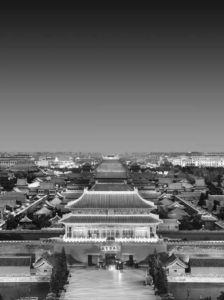
History
Beijing had been the upper-case letter for various groups that held power in northward China for centuries earlier the Forbidden Urban center was synthetic, but it did not become a truly national majuscule until the Mongols swept through China in the thirteenth century. The Yuan Dynasty (1271– 1368) chose Beijing, which translates as "Northern Uppercase," as Red china's seat of power in large part due to its proximity to the Mongol homelands to the northward. The city has been Communist china'southward majuscule ever since—though briefly supplanted by the southern metropolis of Nanjing during the early Ming years and in China's brief Republican era of the first half of the twentieth century. When the Ming Dynasty of ethnic Han Chinese swept the Mongols from ability in 1368, Dadu, Mongolian for "Great Capital," was renamed Beiping, Chinese for "Northern Peace," when the new regime moved to its new capital letter in Nanjing. When Zhu Di, the Yongle Emperor, emerged from a ability struggle with his brothers as Mainland china's new ruler in 1402, he returned the capital to Beijing, where he had been stationed as a Ming prince.i The reign of this clever and ruthless new emperor was characterized by military machine conquest, a purge of strange cultural influences, sweeping reforms for didactics and the economy, and a remarkable edifice spree. On the latter front, the Yongle Emperor ordered the construction of the Porcelain Tower of Nanjing, a chiliad pagoda considered to be 1 of the Seven Wonders of the World before its devastation in 1856; the renovation of the ane,100-mile One thousand Canal, the world'due south longest, between Beijing and Hangzhou; and, of course, his new palace complex in Beijing.
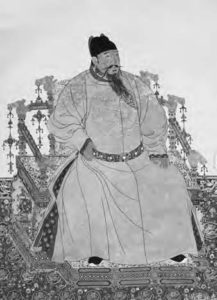
(1360–1424), Zhu Di, was
the tertiary emperor of the
Ming Dynasty in China,
reigning from 1402 to 1424.
Source: Wikimedia Eatables at
http://tinyurl.com/jpby6ef.
English language speakers use the title "Forbidden City," a translation of the Chinese Zijin Cheng. Zi is a contraction of ziwei, or Pole Star, which was the residence of the supreme deity. The Emperor of Red china was the "son of Heaven," the earthly equivalent of the supreme deity on the Pole Star. Jin means "forbidden," and the Forbidden City was indeed inaccessible to ordinary people. Only the highest officials or generals were immune within its walls on Purple business organization. Cheng ways "wall" or "walled enclosure."2 The name Forbidden Urban center did not announced in China until 1576. Nevertheless, work on the Yongle Emperor's new palace began in 1406. The scope of the projection was remarkable, only even more then was the time frame inside which information technology was completed. The complex itself covered seventy-two hectares (approximately 178 acres) separated from the residual of the uppercase by a 10-meter-loftier (approximately xxx-3 anxiety) wall and a fifty-ii-meter-wide (approximately 171 feet) moat. It took roughly a decade simply to get together the required building materials in the capital letter. Timber logs were dispatched by river and took upwards to 4 years to arrive in Beijing, while giant slabs of marble from outlying quarries could only be transported past ice roads in the dead of wintertime. This was an enormous undertaking in and of itself, just the bodily construction phase that lasted from 1417 to 1420 required one million forced laborers and 100,000 craftsmen. Their efforts resulted in the finest display of architecture produced in premodern People's republic of china.iii

tinyurl.com/z4fjpgq.
In 1420, the Yongle Emperor became the first of 20-four consecutive rulers to take up residence in the Forbidden City, though he died just four years later. Over time, numerous buildings in the compound were destroyed, rebuilt, and renamed, only his palace served equally home for xiii more Ming emperors and, following the Manchu conquest of China in 1644, another ten Qing Dynasty emperors. The terminal royal occupant of the Forbidden Metropolis was the boy Emperor Puyi (1906–1967), the final Qing Dynasty ruler, who was allowed to remain in the old Imperial apartments at the dorsum of the palace complex until 1924, long subsequently he had been stripped of his power following Red china'due south 1911 Republican Revolution.4 This was a period of bang-up upheaval as People's republic of china struggled to notice its fashion in the modern world, a process that resulted in the Forbidden Metropolis'southward transition from a imperial palace into a royal public museum.
Design
The Forbidden City did not depart from traditional forms of Chinese Imperial compages, merely rather applied them on a scale that had never before been seen. As such, it conformed to concepts included in the 2nd- century BCE work The Rites of Zhou (Zhou Li). This classic
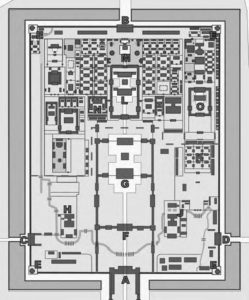
A. Meridian Gate
B. Gate of Divine Might
C. West Glorious Gate
D. Eastward Glorious Gate
E. Corner towers
F. Gate of Supreme Harmony
M. Iii Dandy Halls: The Hall of Supreme
Harmony (bottom), The Hall of Middle
Harmony (center), and The Hall of
Preserving Harmony (top)
H. Hall of Armed forces Eminence
J. Hall of Literary Brilliance
K. Southern Iii Places
Fifty. Two Palaces: The Palace of Earthly
Tranquility (pinnacle edifice), Palace of
Heavenly Purity (bottom building)
Yard. Imperial Garden
N. Hall of Mental Cultivation
O. Palace of Tranquil Longevity
Source:
Wikipedia at http://tinyurl.com/j3bpqbs.
text outlines many longstanding tenets of Confucian thought that were aimed at building and maintaining an orderly society.5 Confucian principles dictated that a properly designed palace compound would use architecture to illustrate the perfect harmony between homo and earth, foster stability, and promote economic prosperity. A book specific to urban planning and compages, The Book of Diverse Crafts (Kao Gong Ji), had emerged earlier in the fifth century BCE, setting out numerous guidelines that were all the same applied by Ming Era builders. For example, it stipulated that the uppercase should be a foursquare oriented to the four cardinal directions, with the master gate facing s and the master road to the palace running on a north– south centrality. The main residence for the emperor and his administrative facilities would be located in the center of the enclosure. These general principles were all incorporated into the Forbidden Metropolis.
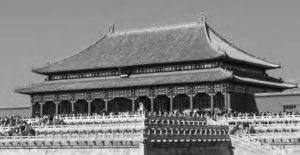
zkzws7x.
The Yongle Emperor's builders erected the Forbidden City in the center of Beijing due to their traditional belief that the seat of ability must exist situated in a cardinal location. As per the guidelines set out in the The Volume of Diverse Crafts, the palace chemical compound was built along a 7,500-meter-long (approximately 24,606 feet) north–south centrality outset at the Gate of Perpetual Peace, Yongdingmen, and running to the Bell Tower. The original compound, parts of which accept been modified or repurposed over time, had three sections: the outset and southernmost has become present-twenty-four hours Tiananmen Square, the centre section consisted of the Forbidden City structures visible today, and the concluding and northernmost was Jingshan Hill. The latter was opened to the public in the 1920s as Jingshan Park, only during the Ming–Qing Era it was dotted with pavilions that made it a identify of repose and solitude. Viewed from the south, Jingshan Hill also served as a scenic backdrop to the Inner City and offered protection from air current and barbaric invaders.six
The starting signal on the Forbidden City'due south axial road is Tiananmen, the Gate of Heavenly Peace, which serves as the southern entrance into the compound from Beijing proper. The road then runs through a big courtyard to Height Gate, actually consisting of five pocket-size gates, which leads into the Inner Metropolis.seven The front end portion of the compound is domicile to the "Three Great Halls," the Hall of Supreme Harmony, the Hall of Middle Harmony, and the Hall of Preserving Harmony, which were used for major ceremonies, banquets, examinations for aspiring bureaucrats, and other functions. To the east and due west, respectively, are the Temple of Heaven, where the emperor would pray, and the Temple of Agriculture, where he made sacrifices that brought good harvests. Set up off the road in this department are rows of smaller, one-story buildings used by the emperor's court ministers. Further off the centrality to the east is the Hall of Literary Luminescence, and to the west is the Hall of Armed services Eminence. In the centre of the Forbidden City one finds the Palace of Heavenly Purity, the emperor and empress's quarters—at to the lowest degree until Qing Emperor Yongzheng (1678–1735) relocated to the Hall of Mental Cultivation to avoid sleeping in the room where his male parent died—and the Palace of Earthly Placidity, which hosted weddings.8 The rear department was the virtually individual and contained halls for ancestors and mourning, forth with the Royal Garden. Elsewhere, buildings would be grouped together in a symmetrical layout off the primary axis according to office, with each cluster including a smaller separate courtyard.
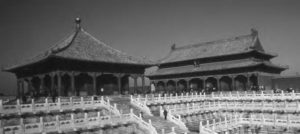
Heart Harmony (left) and the
hipped gable roof on the Hall of
Preserved Harmony (right). Source:
Wikimedia Commons at http://tinyurl.
com/z7z98m9.
The Forbidden City was designed to create a somber, visually hit impression on the select few who had say-so or were allowed to enter the chemical compound. For example, there are no trees outside the Imperial Garden, which made for long walks beyond wideopen spaces as 1 approaches a gate. This was intended to foster deep meditation for anyone almost to begin an audience with a court minister. The high-walled alleys between sections tin fifty-fifty create an intimidating sense of beingness a mouse in a maze. Beast decorations—cultural symbols that add to the chemical compound'due south grandeur—are featured throughout the hall. Dragons, representatives of the emperor's omnipotence, are common, while animals, birds, and flowers (the latter two often being shown together in cases of a shared symbolic meaning) are present on halls used past the empress and the emperor's concubines. For example, the cute white blossoms of the lotus, a flower with Buddhist associations that grew in fetid marshlands, represent the triumph of good over evil, as well equally modesty, unity, and marital harmony. Information technology is typically paired with a duck, another symbol of happiness, or a heron, which represents a want for future success and long life. Gates are guarded by imposing bronze lions, which are not native to Mainland china, arriving every bit gifts from vassal states that symbolize authorization or, in pairs, happiness and prosperity.9

Even the design of the Forbidden Urban center'southward huge roofs held deep cultural significance. The presence of a hip roof (one that slopes down on all sides) that curved upwards to symbolize the highest point in the social bureaucracy signaled a building where the emperor lived or did of import business. The Hall of Supreme Harmony, for example, features a double-eave hip roof to make clear that it was the site of the most significant Imperial ceremonies. A hipped gable roof (featuring a large downward gradient on 2 opposite sides, forth with a smaller, fractional slope on the other two sides) was used for buildings at the next level of importance, such every bit the Hall of Preserving Harmony. Lesser buildings for routine daily functions or amusement used other, less ostentatious styles, such as quadrangle pavilion, overhanging gable, or flush gable.ten
Colors
The Forbidden Urban center's designers opted for assuming colors that served both artful and cultural purposes. In ancient times, the Chinese developed the concept Wu Xing, which sought to explain certain events based on the interaction between different elements. Information technology was applied to fields as diverse as health, science, architecture, and the martial arts. Wu Xing originally centered on five elements (metallic, forest, water, fire, and earth), merely was afterward broadened to include directions and colors (green/blueish, yellow, ruby-red, white, and black), each of which carried
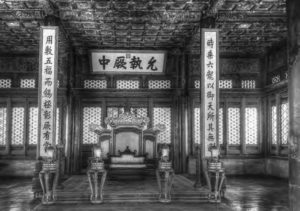
at http://tinyurl.com/gkqpxw4.
great significance.11
The vibrant colors of the Forbidden City are peculiarly pronounced when set against the drab grayness of surrounding buildings and the bright white marble used in the terraces, stairs, and balustrades, only in that location were also very deliberate considerations backside their pick.
The ancient Chinese viewed yellow as the color of earth, producer of all life, which they considered to be the single-most critical chemical element. Thus, yellow was held in particular esteem and was reserved for the exclusive utilize of the emperor. Its prominence in the Forbidden City was meant to illustrate that the emperor, as the son of heaven, had a special connectedness with the earth that legitimized his rule. In fact, Ming law stipulated that yellow could just be used for Majestic palaces, tombs, and temples, and information technology became a custom for emperors to wear yellow robes with an embroidered dragon. Yellow glaze roof tiles, much favored by the Ming Dynasty, feature prominently on great halls and buildings throughout the Forbidden City, and serve as an indication that the emperor would have had concern within the structures. Smaller buildings that served more commonsensical purposes were oftentimes marked with gray roof tiles.12
Upon inbound the Forbidden Metropolis through Tiptop Gate, visitors will come across six taller halls on white marble platforms with yellow-tiled roofs; in the back, in that location are several smaller buildings, besides with yellow covering, that served as living quarters for the emperor's servants and directorate. The walls of the Forbidden City's great halls were washed with yellow clay from Hebei Province to display the royal color

prominently indoors.
There is one exception to the choice of yellowish for Imperial roofing. The emperor's library, the Hall of Literary Profundity (the back portion of the Hall of Literary Luminescence), was given a blackness roof for a very applied reason: the ancient Chinese associated black with water, which the Forbidden City's designers felt would exist very useful in saving the valuable books inside (it once held equally many every bit 36,000) should a fire break out. Elsewhere, green, a symbol of wood and growth, is seen on the roof tiles of several buildings within the chemical compound, such as princes' quarters or other lesser buildings.13
The auspicious color red, which the Chinese associate with power, happiness, wealth, and honour, is ubiquitous in the Forbidden Metropolis. High walls were washed with ruddy clay from Shandong Province, which was also used to gear up roofing tiles in place, and red can be seen prominently on gates, doors, window frames, outside timbers, and interior columns. Such was the Ming'south fondness for red that all reports to the emperor had to be written on red newspaper, while later Qing rulers insisted that any written orders from the emperor were to exist recorded in red ink.14 The intricately decorated interior timbers, pillars, and crossbeams often set carmine against yellow or gold, with elaborate dragon motifs and commonly used Buddhist symbols. Golden leaf from Suzhou was often applied for effectively decorations on pillars and gables.
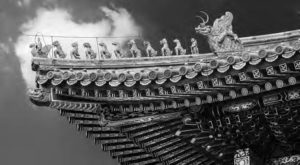
leading up to an Imperial dragon on the right. Source: © chuyuss/Shutterstock photograph.
Numbers
The Chinese philosophical concept of yin and yang, the interconnection of opposites, guided the Forbidden Urban center's designers, forth with Wu Xing. Yang was seen to represent the front and odd numbers (among other things), which explains why the builders chose to cock an odd number, three, of great halls—the Hall of Supreme Harmony, the Hall of War machine Eminence, and the Hall of Literary Brilliance—at the front of the compound. Yin, past contrast, signified the back and even numbers, then there was originally an even number of buildings—the Palace of Heavenly Purity and the Palace of Earthly Placidity—in the rear.fifteen
The Chinese identify great emphasis on numerology and incorporated it into the Forbidden Metropolis's design. For instance, 9 is the greatest single number, which dictated that it, along with the colour yellowish, be reserved for the emperor'southward exclusive apply. Furthermore, the Chinese word for 9, jiu, is also a homonym with "long/lengthy/longevity," which meant that it was doubly auspicious.16 It is often said that the Forbidden City has nine,999 rooms in total (the reality is closer to ix,000), leaving it merely shy of 10,000, the number for infinity, the number of rooms i would notice in the Forbidden Urban center in heaven.
Ix appears repeatedly elsewhere. The original Ming buildings measured nine "trophy" (a measurement for roof spans), wide, and the design chosen for nine gates with watchtowers (all but the Meridian Gate have come down to make fashion for later urban construction). The watchtowers each had nine roof beams, eighteen pillars, and seventy-two ridgepoles.17 This apply of nine and its multiples was a deliberate nod to the emperor's number and when added together would full ninety-nine. Visitors will also notice that the gates in the Forbidden City are decorated with studs that held deeper meaning beyond their decorative value. Whatsoever gate that would be used by the emperor would exist painted bright red and inlaid with 9 rows of nine golden studs. Any commoner who copied the emperor's stud pattern could face execution. Princely gates would take gold studs on red, but they were express to forty-nine in vii rows of seven. Lesser officials would take greenish or black gates, depending on rank, and could have twenty-five bronze or iron studs in five rows of five.xviii

Supreme Harmony. Source: Wikimedia
Commons at http://tinyurl.com/hthh5v7.
Some other hitting element of the Forbidden City is the rows of decorative roof ridge statuettes of mythical creatures used to point the importance of the person establish within, nine representing that elevation. These always appeared in odd numbers—China had a strict patriarchal arrangement, and yang represented both males and odd numbers—and appeared in a specific society. A building used by the emperor, for example, would take all ix statuettes, each of which embodied a particular virtue or protected the compound. The immortal riding a phoenix represented turning bad luck into skilful, the dragon was a symbol of Purple authority, the phoenix signified virtue, the panthera leo showed bravery and warded off evil spirits, the Pegasus demonstrated strength, the bounding main horse brought good fortune, the 2nd lion controlled the rain and prevented disasters, the fish summoned the air current and storms, the goat-bull stood for bravery and power, and the balderdash was a 2nd line of defense against evil omens. Lesser buildings would characteristic fewer statuettes, reducing them from back to forepart. The sole exception to the nine-statuette limit is the Hall of Supreme Harmony, the largest and holiest in the Forbidden City, which had a tenth, the Hangshi, a sword-wielding, monkey-faced immortal that warded off demons. The Palace of Heavenly Purity features ix statuettes, 1 fewer, that are likewise slightly smaller than those institute on the Hall of Supreme Harmony. Other halls had fewer and smaller statuettes, according to their

of the Prc on the rostrum
of Tiananmen, which is often
referred to as the forepart entrance
to the Imperial City, on October 1,
1949. Source: Wikimedia Commons at
http://tinyurl.com/jk25445.
significance.nineteen
Conclusion
Mao Zedong, who governed as China'southward offset Communist dictator from 1949 to 1976, mercifully chose to spare the Forbidden City a date with the wrecking brawl after his forces entered Beijing (and then Beiping) in January 1949. Many Communists associated the Forbidden Metropolis with a feudal system that had long left the nation'south hundreds of millions of poor peasants to endure in grinding poverty, just Mao ultimately decided against satisfying the rash impulses of and so many of his fellow revolutionaries who wanted to destroy information technology. Instead of razing the Forbidden Metropolis, he chose information technology as the site for a public celebration on October 1, 1949, of the Communist victory in the Chinese Civil War.twenty His watchful portrait at present hangs over the Gate of Heavenly Peace just below the spot where he formally declared the establishment of the People's Commonwealth of China. When overzealous youth in the Red Guard went on a binge of destruction directed at vestiges of Communist china's feudal past during the Cultural Revolution (1966–1976), Premier Zhou Enlai wisely ordered the regular army to close the Forbidden Urban center to the public to spare it from Mao's sick-directed wrath.21 Many of Beijing'southward temples and celebrated buildings were tragically destroyed during this period. Soon after Mao'due south expiry, China began to break free from what US President Richard Nixon once called a period of "angry isolation" in club to reengage with the world.22 Four decades into its reform period, Cathay is now wealthier and more powerful than information technology has been for centuries. China's capital has seen a remarkable building boom over the past decade, to such an extent that Beijing is dotted with some of the most visually stunning skyscrapers always congenital, and the aboriginal Forbidden Metropolis has now become the globe'due south most visited tourist attraction. Were he able to see this, the Yongle Emperor would doubtlessly be immensely proud of the former and offended to his core past the latter.
NOTES
ane. Geoffrey Parker, Power in Stone: Cities as Symbols of Empire (London: Reaktion Books, 2014), 83.
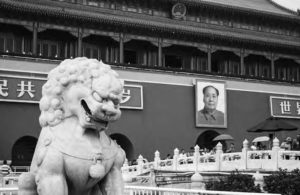
tinyurl.com/hk45l5j.
2. Frances Woods, Forbidden Metropolis (London: The British Museum Press, 2005), 7.
3. Lou Qingxi, trans. Li Zhurun, The Architectural Fine art of Aboriginal China (Beijing: China Intercontinental Printing, 2001), 25.
four. Wood, 68.
5. For more on Confucianism, see Dingxin Zhao'due south The Confucian-Legalist State: A New Theory of Chinese History (New York: Oxford Academy Press, 2015).
vi. Qingxi, 25.
7. M. A. Aldrich, The Search for a Vanishing Beijing: A Guide to China's Capital through the Ages (Hong Kong: Hong Kong University Press, 2008), 91.
8. Weng Wan-become, The Palace Museum: Peking, Treasures of the Forbidden City (New York: Abrams, 1982), 41–49.
9. Laurence Sickman and Alexander Soper, The Fine art and Compages of China (Baltimore: Penguin Books, 1960), 285.
ten. Qiu Xiuqing, "Roofs in the Forbidden City: A Cultural Perspective," China and the Globe Cultural Exchange 1 (2013): 35–36.
11. Aihe Wang, Cosmology and Political Culture in Early on China (Cambridge: Cambridge University Printing, 2000), 6.
12.Yang Chunfeng and Wan Yi, "The Colourful Glazed Forbidden Metropolis," Communist china and the World Cultural Exchange 6 (2004): x–12.
thirteen. Qingxi, 46.
14. Peng Hong, "Beijing Zijin Cheng jianzhu yishu de wenhua xiangzheng yiyi (On Cultural Symbolic Meaning in the Architectural Fine art of the Forbidden City)," Hengyang shifan xueyuan xuebao (Journal of Hengyang Normal University) five (2003): 112–113. xv. Ibid.
16. Geremie R. Barmé, The Forbidden City (London: Contour Books, 2008), 35.
17. Bo Hua and Huang Weite, "Zijin Cheng jianzhu de zhengzhi neihan (The Implied Political Meaning of the Architecture of the Forbidden Metropolis)," Gugong xuekan (Journal of Gugong Studies) i (2011): 98.
xviii. Qingxi, 47.
19. Ibid., 35.
xx. Barmé, xv.
21. Eugenio Bregolat, trans. Joyce McFarlane, The Second Chinese Revolution (London: Palgrave MacMillan, 2015), 155.
22. Richard Nixon, "Asia After Vietnam," Foreign Diplomacy 46, no. i (1967): 17.
JIE GAO is an Assistant Professor of History at Murray State University in Kentucky. She obtained her PhD from The Academy of Western Ontario in Canada, and her MA and double BA from Beijing University in China. Gao has engaged in the study of modern Chinese history in China, Canada, and the Usa. Her research interests include popular culture, intellectual history, sino-strange relations, and women'south studies. Her work has appeared in numerous journals and books. Currently, she is working on her manuscript, "Saving the Nation through Culture: The Folklore Movement in Republican China (1918–1949)," and a new projection on Chinese cigarette cards.
Source: https://www.asianstudies.org/publications/eaa/archives/symbolism-in-the-forbidden-city-the-magnificent-design-distinct-colors-and-lucky-numbers-of-chinas-imperial-palace/
0 Response to "Forbidden City Floor Plan Old Drawings"
Отправить комментарий